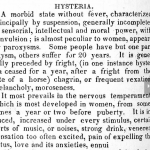“Mr. Hartright, you surprise me. Whatever women may be, I thought that men, in the nineteenth century, were above superstition” (62.)
Miss Halcombe rebukes Hartright’s superstition when he states that Laura’s resemblance to Anne “seems like casting a shadow” (62) on her future. The language of superstition tracks throughout the early parts of the narrative, increasing the sensational aspects of the novel. However, each instance is rejected as nonsense or overactive imagination, as Jacob Postlethwaite’s ghost “Arl in white—as a ghaist should be” (87) is dismissed. As Miss Halcombe seems to believe, the nineteenth century is too enlightened for ghosts and superstition.
The Victorian Gothic situates elements of the supernatural into a realistic setting. This realism tinged with the uncanny perhaps provides a space for the discussion of taboo topics. The first ghostlike appearance of the woman in white on the road to London immediately associates her with a spirit, rather than a scandalous lady of the night. This may allow Collins to work with her character without excessive criticism. Even her stance when the woman asks Hartright a question is incredibly gothic: “her face bent in grave inquiry on min, her hand pointing to the dark cloud over London” (24). Obviously, this is a very unnatural way to ask a question, so by making the woman in white slightly off-putting or unhuman, Collins subverts some degree of sexual scandal in this section.
Doing this work is critical for the character of Anne Catherick, as she is the most easily provocative character at this point. She is consistently violating the rules of propriety and her past is rather uncertain. But by giving her ghostlike qualities, referencing European superstitions about a wraith-like woman or spirit all in white, Collins is ultimately able to write a character who breaks rules of propriety and conduct without his novel being entirely dismissed for sexual or provocative content. Her sudden and ghostly appearances and features, “deathlike stillness” (95) on her face or the petrifying nature of her touch (23, 97) all give her a spirit-like qualities, and these potentially free her from certain confines a character with purely human appearances might be under. Essentially, her otherness prevents an audience from judging her actions and appearance by normal standards as she seems to be supernatural.
While ultimately, Collins writes a sensation novel and gothic aspects are expected in that genre, he enjoys an element of freedom by working in allusions to the supernatural. Cohen’s writing on sex scandals and their effect on the Victorian novel hypothesized that the length of these novels was in part due to the urge to avoid explicitly speaking about sex while still producing works that comment on sexuality, gender roles, and sex through coded language (Cohen). The spooky setting of the Victorian Gothic provides a similar freedom as the uncanny and quasi-supernatural aspects cover a degree of the scandalous and provocative content.


